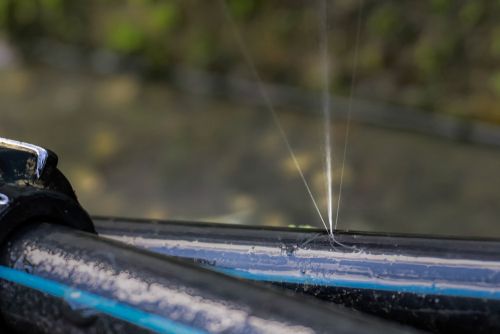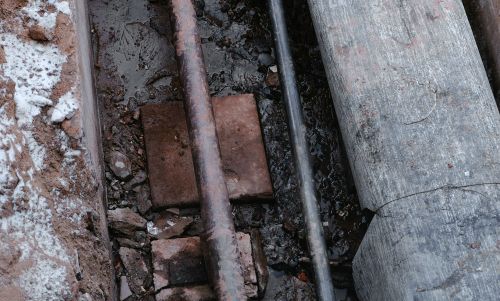If you suspect you have leaking pipes, or if you have already been told you have a leak, you may have heard the terms “slab leak” and “pinhole leak.” Let’s take a look at these two plumbing problems so you understand what they mean, what causes them, and how you can repair these leaks.
What Is a Pinhole Leak?
A pinhole leak is a tiny leak in a pipe about the size of a pinhole, hence the name. This type of leak is found in copper pipes and may be seen anywhere in a building. Pinhole leaks can occur as a single leak, in clusters, or along the length of a pipe. However, once you read below about the various causes of pinhole leaks, you’ll understand why if you see one, you probably have more.

What Causes Pinhole Leaks?
There are multiple causes of pinhole leaks. Sometimes, pinhole leaks in your pipes can be the result of more than one cause.
Corrosion of Copper Piping
Age can contribute to the corrosion of copper piping, even though it is generally considered a long-lasting pipe material. There are additional factors that can speed up corrosion, however, particularly with what is known as pitted corrosion:
- High chlorine levels in your tap water
- Rust in the hot water heater
- High water pH (measures acidity)
- Microbes (bacteria) in the water or soil
Velocity of Water Within a Pipe
Your plumbing system should be adjusted so the speed of water in your pipes is limited to five feet per second (5 fps) for hot water and eight feet per second (8 fps) for cold water. This helps reduce turbulence within the pipes. However, when water velocity is too high, turbulence is increased, which can eventually cause wear and pinhole leaks in the pipes.
Spacing of Pipe Fittings
Inadequate spacing between your pipe fittings can also contribute to turbulence. If your pipes’ fittings are too close together, turbulence is greater, and this may produce pinhole leaks as well. Ideally, fittings should be no less than about five pipe diameters apart, but your plumbing code will determine this precisely. So, if your pipe measures one inch across, there should be five inches between fittings.
What Are the Signs of Pinhole Leaks?
Depending on where they occur, pinhole leaks may be easy to spot, or you may have to do a bit of detective work. In an exposed pipe, for example, a pipe in the rafters of an unfinished basement, you may actually see water spraying from a tiny hole or a group of holes in the pipe. Otherwise, look for these signs, which can indicate pinhole leaks in your copper pipes:
- An increase in your water bill or a water bill that seems way too high for your water use and your location
- Dripping coming from behind your walls or under your floors
- Mold, mildew, or stains on your walls or floors
- Dimpling or obvious wear in your copper pipes
Can You Prevent Pinhole Leaks?
If you have copper pipes, there are steps you can take to prevent pinhole leaks. In addition to replacing copper piping that is very old (at least 20 years):
- Have a professional plumber inspect your pipes every year.
- Install a water softener to prevent hard water, which is rough on pipes.
- Reduce the turbulence in your pipes by controlling the velocity of the water in your plumbing and by ensuring fittings are spaced far enough apart. In some cases, you may need wider pipes to reduce the turbulence.
What Is a Slab Leak?
A slab leak is a plumbing leak that occurs under the slab foundation of your home. Sometimes slab leaks start out as pinhole leaks in copper pipes, however not all pinhole leaks are slab leaks, nor are all slab leaks pinhole leaks. Sometimes a slab leak can occur in the form of a cracked or completely broken pipe.

How Are Slab Leaks Caused?
Like pinhole leaks, slab leaks can have multiple causes, some of which can occur simultaneously.
Installation Problems
If the pipes running beneath your slab weren’t installed properly, a leak can develop. Sometimes this happens with inexperienced plumbers or DIY construction jobs. On other occasions, the pipe may have been damaged before it was installed but the damage went unnoticed.
Shifting of the Ground
Movement of the ground under a slab is a very common cause of slab leaks, especially in earthquake-prone locations. However, it doesn’t take an earthquake to make the ground shift; climates with cycles of freezing and thawing temperatures can also produce enough changes in the ground level to damage pipes.
Corrosion
As mentioned above, corrosion can cause pinhole leaks, which can be a type of slab leak. Hard water, chlorine, rust, and other undesirable elements in your water can all cause copper pipes to corrode, especially if they are older.
Abrasion
Your pipes may rub on rough surfaces, whether that’s the soil beneath your slab or other pipes. This friction can also cause damage to the pipe below your slab.
How Do You Know You Have a Slab Leak?
If you have a slab foundation and notice any of the following, you may have a slab leak:
- Your water bill is much higher than normal or not right for your personal use or your location.
- You can hear water running or dripping even when your water is turned off at the tap.
- Your water meter dial moves even when your water is shut completely off.
- You notice moisture, mold, or mildew under your carpeting or flooring. Your floor may have a “boggy” feel, slightly concave areas, or swelling.
- You see water stains, mold, or mildew where the wall meets your floor or on your baseboards.
- There are cracks in your floor, your baseboards, or the lower part of your walls.
- You turn the tap open all the way, but there is little water pressure because the water is escaping through a leak under your slab.
- Your floor has uneven temperatures. You may notice hot or cold spots in certain areas.
- You smell mold in the environment but can’t figure out where it’s coming from.
- There is water standing around the outside of your house, usually close to the home’s perimeter.
- Your water tastes or smells bad.
If you notice any of these warning signs of a slab leak, call a professional plumber immediately. A plumber experienced with slab leaks can use thermal imaging, sonic detection, and electronic amplification to ascertain whether or not you have a slab leak and find its location.
What Are the Consequences of Pinhole and Slab Leaks?
Both pinhole and slab leaks can have devastating consequences for homeowners. Water leaking slowly can damage your floors, your ceilings, and your walls, as well as your belongings inside your home. You may have to replace flooring or carpeting or repaint damaged areas. It can be very challenging to get rid of mold once it takes hold inside the home.
Unrepaired leaks can run up your water bill. Sizable leaks are akin to leaving your tap open 24/7. In areas where water is in short supply, this is also wasteful.
A slab leak can cause long-term damage to your foundation. If the leak goes on long enough, your foundation could collapse, causing damage to the entire home’s structure.
How Can You Repair Pinhole and Slab Leaks?
Fortunately, both pinhole and slab leaks can often be repaired, especially when caught early enough.
With pinhole leaks, if the pinhole damage is small, sometimes just replacing that stretch of pipe is sufficient. Obviously, the more accessible the pipe is, the easier this repair will be. At the same time, your plumber can check to make sure that factors contributing to pinhole leaks are remediated, such as hard water, high velocity in the pipes, or pipe fittings that are too close together. This can help prevent future pinhole leaks in your pipes.
Slab leaks are more complicated to repair because the pipe is under your foundation. Of course, as a homeowner, you want to consider every option that does not entail digging up your foundation, which is costly, messy, and disruptive. Luckily, in some cases, pipelining may be an option.
Pipelining allows the plumber to insert a lining inside the original damaged pipe without having to do any extensive digging. The lining is made of a soft material coated in epoxy, which cures in place once inside the old pipe.
Pipelining is ideal for pinhole leaks and similar situations where there is enough integrity remaining in the original pipe for it to give the lining something to adhere to, and when the pipe isn’t bent or too far out of alignment. Pipelining can be used for other types of plumbing repairs as well, including inside the home and in lateral sewer lines.
If pipelining is not an option, there are other choices your plumber may suggest:
- Direct repair, which involves jackhammering the slap to replace damaged segments of pipe
- Rerouting the pipe, taking the pipe from below the slab to above the slab
- Full repiping, which means replacing the complete pipe system
If you have questions about pinhole or slab leaks, contact San Diego Pipelining today. We’ll be happy to send an expert to your home to see if you need a pipe repair and we can talk to you about pipelining and other repair options to select the best method for your home’s plumbing.
